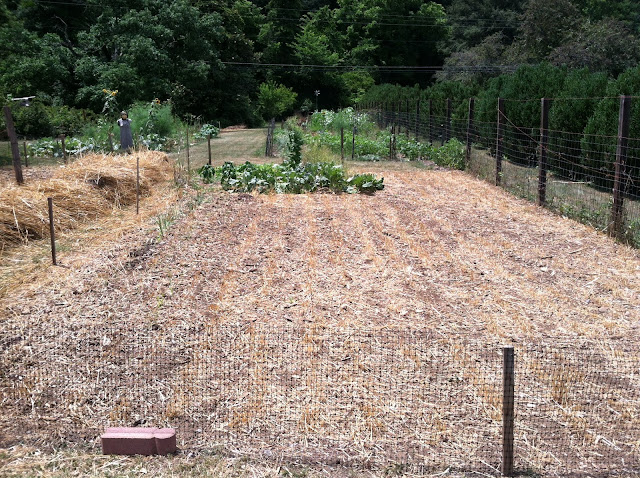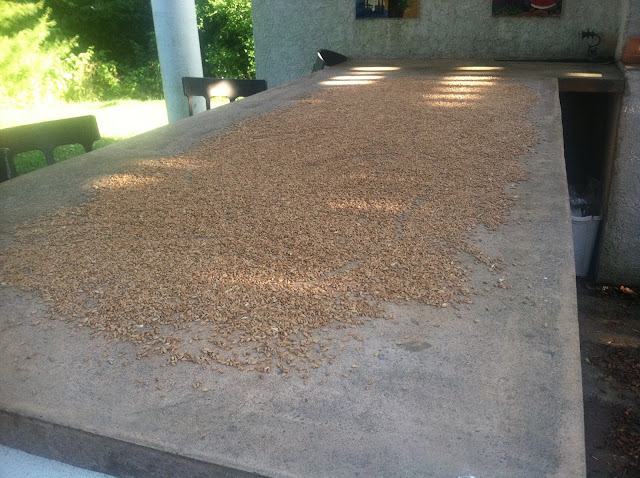I know I've blogged about this before but it's what's happening now at Elk Cliff Farm. James plants winter wheat as a cover crop for many of his gardens. Last fall he planted more than ever. Come spring he has to decide what he's going to do with the wheat. His options are to pull it out, cut it off or till it under the soil. I'm not sure I understand cover crops very well but each year I learn a little more about them. This is how I understand it. The wheat is planted to feed nitrogen to the soil. (see edit below). It also helps retain water and prevent weeds from taking over. This year's lesson for me was about mycorrhiza. It's like a web of fungus and roots underground that work together to improve the soil. The plant above ground feeds the roots and fungus underground and vice versa. It keeps spreading throughout the garden and makes for happy future gardens. Ok, that's really not a good description but I'm not a very good student and that's the best I can do. Ask a real gardener if you're interested in the real scoop.
What he chose to do with much of it was cut the tops off so we can use the wheat berries for flour for bread, pasta etc. Then he cut the wheat straw off with a scythe and mowed the rest with the lawn mower so it was close to the ground. The roots remain in the soil and he plants between them. Did I say that we cut the wheat heads off with scissors?
This is what the garden looks like after the wheat straw has been cut down to a few inches. James says the ground is pretty loose between the rows so all he has to do is hoe between them and plant.
Next the wheat heads are placed on a tarp and danced on.
This breaks the wheat berries out of their shells or chaff. I separate what straw I can and scoop up the wheat and chaff and put it into a cooler of water. There the wheat berries fall to the bottom of the cooler and I can remove the chaff and other unwanted stuff. I wash the wheat pretty well then dry it on a large countertop. When it's dry I pack it up and put it in the freezer till I'm ready to use it.
It's organic seed, grown organically and processed manually so I wonder how much different our wheat bread is from what you buy at the store. Neither of us has problems tolerating gluten and we wonder if someone who thinks they're gluten intolerant could eat our wheat and not be bothered by it. We have 16 more garbage bags full of wheat to be cleaned. I've done 6 so far. I'm figuring we'll get about 77 lbs of wheat this year.
When I'm done my job the clean up crew comes in.
(edit) I've been corrected about the wheat feeding nitrogen to the soil. I should have written
Winter wheat plantings help recover soil fertility by essentially dredging up nitrogen and other nutrients that have leached into deep soil layers. As winter wheat grows, roots absorb these nutrients and move them internally toward their aboveground leaves. Tilling winter wheat into soil in spring places these nutrients in the root zone of new vegetable plantings.
What he chose to do with much of it was cut the tops off so we can use the wheat berries for flour for bread, pasta etc. Then he cut the wheat straw off with a scythe and mowed the rest with the lawn mower so it was close to the ground. The roots remain in the soil and he plants between them. Did I say that we cut the wheat heads off with scissors?
This is what the garden looks like after the wheat straw has been cut down to a few inches. James says the ground is pretty loose between the rows so all he has to do is hoe between them and plant.
Next the wheat heads are placed on a tarp and danced on.
This breaks the wheat berries out of their shells or chaff. I separate what straw I can and scoop up the wheat and chaff and put it into a cooler of water. There the wheat berries fall to the bottom of the cooler and I can remove the chaff and other unwanted stuff. I wash the wheat pretty well then dry it on a large countertop. When it's dry I pack it up and put it in the freezer till I'm ready to use it.
It's organic seed, grown organically and processed manually so I wonder how much different our wheat bread is from what you buy at the store. Neither of us has problems tolerating gluten and we wonder if someone who thinks they're gluten intolerant could eat our wheat and not be bothered by it. We have 16 more garbage bags full of wheat to be cleaned. I've done 6 so far. I'm figuring we'll get about 77 lbs of wheat this year.
When I'm done my job the clean up crew comes in.
(edit) I've been corrected about the wheat feeding nitrogen to the soil. I should have written
Winter wheat plantings help recover soil fertility by essentially dredging up nitrogen and other nutrients that have leached into deep soil layers. As winter wheat grows, roots absorb these nutrients and move them internally toward their aboveground leaves. Tilling winter wheat into soil in spring places these nutrients in the root zone of new vegetable plantings.





Our home grown wheat still has some of the chaff stuck to the wheat berries. I can hand pick through it and manually break the seed free from the chaff by rubbing it firmly between my fingers, but there must be a better (faster) way.
ReplyDelete